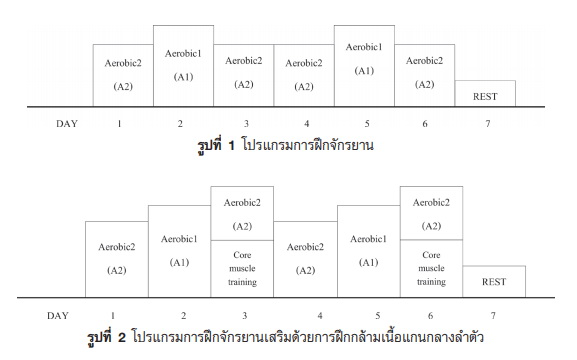EFFECTS OF ADDITIONAL CORE MUSCLE TRAINING ON CYCLING PERFORMANCE IN YOUTH MALE TIME TRIAL CYCLISTS
Main Article Content
Abstract
Purpose To determine the effects of additional core muscle training on cycling performance in youth male time trial cyclists
Methods Youth male time trial cyclists, mean aged 16±2 years, were recruited. The purposive sampling by ranking core muscle strength was used to divide the participants into two groups: the cycling training group (CT; n=13) and the cycling combined with core muscle training group (CT+CMT; n=12). Both groups performed cycling training program at the intensity of 65-80 %HRmax twice a week and 80-90 %HRmax for 4 days/ week. The additional core muscle training program consisted of core muscle training using Swiss ball and weight machine at the intensity of 75%of 1 Repetiton Maximum (RM) for 2 days/week. The variables including general physiological, cycling performance; 20 km time trial, cycling balance skill and time to fatigue as well as core muscle strength were determined before and after 8-week of intervention period. The 2x2 (groups x times) ANOVA with repeated measures followed by LSD multiple comparisons were used to determine significant differences among all variables.
Results After 8 weeks of training, maximal oxygen consumption increased in both cycling training and cycling combined with core muscle training groups (p< .05). The CT+CMT group had significantly decreased time trial 20km. duration (all p< .05). Moreover, the CT+CMT group had significantly increased time to fatigue, cycling balance skill and core muscle strength (p< .05). The CT+CMT group had significantly higher peak torque of core muscle in trunk extension and flexion positions and lower core muscle fatigue in trunk extension positions than the CT group (p< .05).
Conclusion The cycling combined with core muscle training can improve cycling performance such as cycling balance skill, time to fatigue and time trial 20 km. duration while the cycling training only did not improve those cycling performances.
Article Details
References
Alan, M. (2011). Cyclingtips : The pursuit of leanness. (Online). Retrieved April 3, 2019, from Cyclingtips Website https://cyclingtips.com/2011/11/the-pursuit-of-leanness/
Asplund, C., and Ross, M. (2010). Core stability and bicycling. Current Sports Medicine Reports. 9(3), 155-160.
Atkinson, G., Peacock, O., & Passfield, L. (2007). Variable versus constant power strategies during cycling time-trials: Prediction of time savings using an up-to-date mathematical model. Journal of Sports Sciences, 25(9).
Burke E. (2002). Serious Cycling 2nd Edition: Human Kinetics.
Cain S. M., Ashton M., James A., and Perkins N.C. (2016). On the skill of balancing while riding a bicycle. PLoS ONE.
Duc, S., Bertucci, W., Pernin, J., and Grappe, F. (2008). Muscular activity during uphill cycling : Effect of slope, posture, hand grip position and constrained bicycle lateral sways. Journal of Electromyography and Kinesiology, 18(1), 116-127.
Ducheyne, F., Bourdeaudhuij, I., Lenoir, M., & Cardon, G. (2013). Does a cycle training course improve cycling skills in children? Accident Analysis and Prevention, 59, 38-45.
Faria, E. W., Parker, D. L., and Faria, I. E. (2005). The science of cycling physiology and training – part 1. Journal of Sports Medicine, 35(4), 285-312.
Faria, E. W., Parker, D. L., and Faria, I. E. (2005). The Science of cycling factors affecting performance – part 2. Sports Medicine, 35(4), 313-337.
García-Vaquero, P.M., Barbado, D., Juan-Recio, C., López-Valenciano, A. and Vera-Garcia, F. J. (2016). Isokinetic trunk flexion–extension protocol to assess trunk muscle strength and endurance: Reliability, learning effect, and sex differences. Journal of Sport and Health Science. 2016: 1-10.
Hawley, A. J., & Noakes, D. T. (1992). Peak power output predicts maximal oxygen uptake and performance time in trained cyclists. Journal of Applied Physiology, 65, 79-83.
Lucia, A., Hoyos, J., Perez, M., and Chicharro, J. L. (2000). Heart rate and performance parameters in elite cyclists: a longitudinal study. Journal of Medicine and Science in Sports and Exercise, 32(10), 1777-1782.
Laursen, P. B., Shing, C. M., & Jenkins, D. G. (2003). Reproducibility of the cycling time to exhaustion at VO2peak in highly trained cyclists. European Journal of Applied Physiology, 28(4).
Ronald, P. P., Brian , H., David, L., Daniel, B., and Kevin, H. (1993). Correlating indices of aerobic capacity with performance in elite women road cyclists. Journal of Strength and Conditioning Research., 7(4), 201-205.
Samson K. M. (2005). Effects of a five-week core stabilization-training program on dynamic balance in tennis athletes. Athletic Physical Therapy Today. 12(3).41-46
Suksom D. (2018). Exercise for health. Bangkok. Chulalongkorn University Printing House.
Tabata, I., Ogita, F., and Miyachi, M. (1996). Effects of moderate intensity endurance and high intemsity intermittent training on anaerobic capacity and VO2max. Medicine & Science in Sports & Exercise, 28(10), 1327-1330.
Thongho I. (2017). Effect of recovery after exercise methods on lactic acid in the blood, heart rate and anaerobic performance in athletes. Journal of Health, Physical Education and Recreation, 43(1), 290-316.
Union Cycliste Internationale. (2017). Amendments to regulations. (Online). Retrieved October 11, 2017, from Website: https://www.uci.ch/mm/Document/News/Rulesandregulation/Colonnededroite-changementsau01.01.2018-Majdu01.10.2017-E_English.PDF
Weijmans, E., and Berkel, S. v. (2014). Do core stabilization exercises enhance cycling efficiency?. Journal of Science and Cycling. 3(2), 71.
Weston, R. A., Myburgh, H. K., Lindsay, H. F., Dennis, C. S., Noakes, D. T., & Hawley, A. J. (1997). Skeletal muscle buffering capacity and endurance performance after high-intensity interval training by well-trained cyclists. European Journal of Applied Physiology, 75, 7-13.
Wilber, C. A., Holland, C., Madison, R. E., and Loy, F. A. (1994). An pidemiological analysis of overuse injuries among recreational cyclists. Journal of Sports Medicine, 16(3), 201-206.
Willardson, M. J. (2007). Core stability training : Applications to sports conditioning programs. Journal of Strength and Conditioning Research, 21(3), 979-985.
Willardson, M. J., Fontana, E. F., & Bressel, E. (2009). Effect of surface stability on core muscle activity for dynamic resistance exercises. Journal of Sports Physiology and Performance, 4(1), 97-109.
Wiseman, K. (2013). An investigation into the effectiveness of core muscle strengthening on cycling performance in asymptomatic cyclists. Masters’ Degree in Technology, Chiropractic Durban University of Technology.


